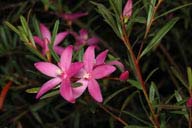In Flower This Week
A weekly news sheet prepared by a Gardens' volunteer.
Numbers before each plant refer to temporary IFTW labels in the gardens.
Numbers in square brackets [ ] refer to garden bed Sections. Plants in flower are in bold type.
View past issues of 'In Flower This Week'.
28 May 2014
Crowea 'Cooper's Hybrid' click for larger image |
A walk along the curvaceous Main Path from the Visitor Centre towards the Eucalyptus Lawn, Red Centre Garden and Sydney Region Flora section.
- Near the Visitor Centre door, Lechenaultia formosa [Section 221] is a small attractive plant from WA, with close, grey-green foliage and bright red flowers with orange centres.
- On the left, behind the bright yellow flowers of Hibbertia vestita, is Prostanthera phylicifolia[Section 210] which has masses of mauve flowers and aromatic foliage.
- At the Café bridge, on the left, is Olearia argophylla [Section 305], known as ‘Native Musk’. It is a small tree with terminal clusters of dainty, white, five-petalled flowers and bicoloured serrated leaves, with silver on the underside.
- Cross the bridge and follow the Main Path to the right, past the Café. On the left, near the door to the Ellis Rowan Building, is Correa baeuerlenii [Section 131], or Chef’s Hat Correa. It has long, green, tubular flowers with protruding stamens; the “cap” has a citrus aroma.
- Further on the right beneath a Brittle Gum tree (Eucalyptus mannifera), is Crowea ‘Cooper’s Hybrid’ [Section 240], with pink, star-shaped flowers.
- Acacia alata var. biglandulosa [Section 240], the Winged Wattle from WA, has a profusion of small, cream, ball-shaped flowers attached to unusual zig-zag stems.
- Continue along the Main Path to a large bush of a Thryptomene species [Section 10] on the left; this has tiny, dainty, open-petalled, pink flowers, in clusters.
- Further on the left, behind the Melaleuca fulgens ‘Hot Pink’ is Callistemon subulatus [Section 10], with bright, red flower spikes. Both these plants are members of the Myrtaceae family and have reduced petals and many stamens, giving a fluffy “bottlebrush” appearance to their flowers. This contrasts with Thryptomene (#7), which is a member of the same family but has more prominent petals and fewer stamens.
- Continue along the Main Path to the Proteaceae Section and find on the left Banksia ericifolia subsp. ericifolia [Section 30], Heath Banksia, with glowing orange flower spikes when mature.
- On the right is Banksia heliantha [Section 30] from WA, previously known as Dryandra quercifolia before reclassification as a banksia. The flower heads are spherical, orange in bud and opening to yellow.
- Nearby on the left, is Banksia spinulosa ‘Birthday Candles’ [Section 30], a low shrub with needle-like foliage, and yellow flower heads. It also bears older fruiting cones with hard nut-like follicles containing seed.
- Before crossing the road, on the right, is Grevillea ‘Coconut Ice’, with spectacular, large, orange-pink sprays of flowers.
- Over the road and further along the Main Path, on the right, is a small bush of Grevillea centristigma [Section 25], with bright yellow flowers and orange stamens. The leaves are narrow-elliptical to narrow-obovate. It is endemic to south-west WA.
- Further along, on the left, is Grevillea phanerophlebia [Section 24], a large shrub, with delicate, white, feathery flowers.
- Just before the road, also on the left, is a large, sprawling shrub of Grevillea ripicola [Section 24], with red and gold spider-like flowers. It is from southwest WA and often found along river banks. This is reflected in the species name – ripa- meaning, in Latin, river bank and -cola meaning dweller.
At the intersection of the Main Path with the road, continue on to see the Sydney Region Flora or turn left to go to the Eucalyptus lawn and further on to the Red Centre Garden.
Anne Campbell,
Roslyn Joslin &
Linda Beveridge
![Director of National Parks [logo]](../../../../images/dnp_90px.gif)







